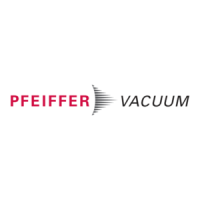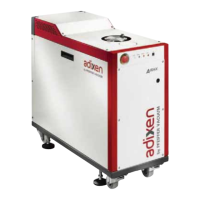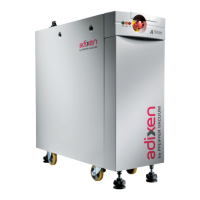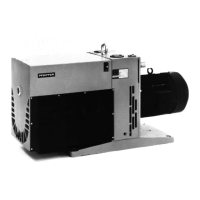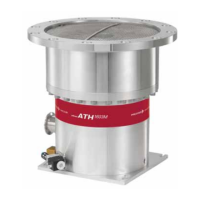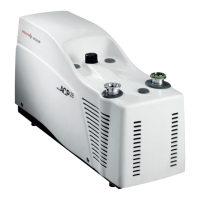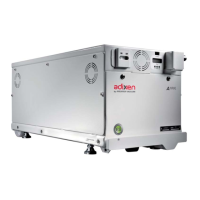
Do you have a question about the Pfeiffer Vacuum Adixen A100L Series and is the answer not in the manual?
| Brand | Pfeiffer Vacuum |
|---|---|
| Model | Adixen A100L Series |
| Category | Water Pump |
| Language | English |
Lists the typical uses of the dry pump.
Highlights key characteristics of the A100L pump.
Outlines the advantages of using the A100L dry pump.
Details the connection points and panels on the pump.
Describes the pump's internal cooling circuit and energy saving option.
Describes the location and function of the electrical and electronic cabinets.
Details monitoring system parameters and main functions.
Specifies operating requirements for altitude, humidity, and temperature.
Describes an accessory for securing the pump against seismic activity.
Details the function and importance of the emergency stop device.
Explains the accessory to reduce exhaust sound level.
Details the kit for closing and pressurizing the pump.
Describes an accessory for reducing vibrations.
Explains the interface for pump control and communication.
Provides general safety guidelines and warnings for installation and use.
Explains the meaning of various safety labels on the pump.
Specifies electrical supply voltage, current, and breaker ratings.
Details gas inlet and exhaust flange specifications.
Outlines requirements for cooling water supply and specifications.
Specifies requirements for inert gas or compressed dry air supply.
Advises on handling, lifting, packaging, and general precautions.
Details procedures for safely moving and lifting the pump.
Provides conditions for storing the pump correctly.
Guides on placing the pump horizontally and levelling it.
Explains how to safely stack two pumps together.
Lists required water quality parameters for the cooling circuit.
Details requirements for proper grounding and earth conductors.
Explains the need for circuit breakers and their specifications.
Covers wiring for high voltage power supply.
Covers wiring for low voltage power supply.
Advises on material compatibility and leak testing.
Specifies exhaust connection type and pressure rating requirements.
Specifies inlet connection type and vacuum line requirements.
Explains pump control and monitoring capabilities via dry contacts.
Identifies the physical location and plug type for remote control.
Details pin assignments for dry contact signals.
Explains pump control and monitoring capabilities via dry contacts.
Identifies the physical location and plug type for remote control.
Details pin assignments for dry contact signals.
Describes local, remote control, and starting mode options.
Describes the procedure for starting the pump in autostart mode.
Explains how to stop the pump and handle auto-restart.
Details starting the pump via remote control signals.
Explains how to adjust pump rotation speed via voltage control.
Explains the function of warning and hazard temperature sensors.
Covers safety for maintenance, including shock and hot surface hazards.
Covers procedures for safely cleaning and dismantling the pump.
Explains how to interpret indicator lights on the front panel.
Provides steps to diagnose common pump issues and indicators.
Advises on safety precautions when moving the pump.
Step-by-step guide to safely drain the pump's cooling circuit.
Details procedures for safely disconnecting and preparing the pump for shipping.
Emphasizes using genuine parts for safety and performance.
Lists common replacement parts and their part numbers.
Official statement confirming compliance with European directives.
Presents wiring diagrams for different pump configurations.
Details the process and form for returning products for service.
Guides on installing the network interface module.
Explains how to wire and configure the serial communication interface.
Describes how to control the pump using the RS232 serial link commands.
